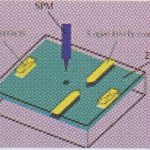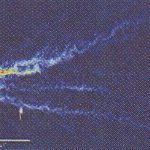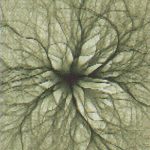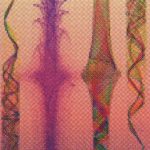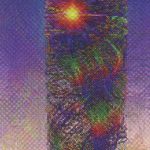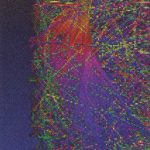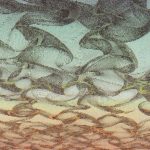Eric Heller: Caustic I
Artist(s):
Title:
- Caustic I
Exhibition:
Creation Year:
- 2002
Medium:
- lightjet print
Size:
- 36 x 46 inches
Category:
Keywords:
Artist Statement:
There is no need to be an expert in celestial mechanics to marvel at a lunar eclipse. Few can look at a space telescope image with hundreds of galaxies without a passing thought about our place in the universe. Indeed, astronomy enjoys an immediate visual accessibility and appeal that most physical sciences do not. I view my role as an artist-scientist as attempting to make the mystery and beauty of other aspects of nature more apparent to nonspecialists. My subjects come from what I know best-those fields where I do research: quantum mechanics, chaos theory, nanoscale physics, and chemical physics.
Science these days generates many beautiful images. But the scientific illustrations must put science first. My images do not attempt so much to teach or to convey information as to convey the emotion of discovery, of knowing nature at her deeper levels. My computer-generated images are based on science, but the scenes are created rather than found. My work uses diverse physical phenomena as a medium for painting scenes that seem somehow familiar. The familiarity banks heavily on nature’s passion for repeating herself. It is key to the emotional engagement I hope to achieve.
Technical Information:
When a water colorist puts a wet brush to paper, physics rules the result: wetting and fluid flow on paper, scattering and absorption of light by pigment on fibers, evaporation and drying hold sway. These physical phenomena mimic other aspects of the natural world and with experience can be harnessed to wonderful effects. Similar statements hold for pastels, egg tempera, oils, photographs, etc. To date, digital painting tools have tried to emulate traditional media and effects. Digital artists need no longer emulate traditional media only. The computer allows us to create new media, with new rules, more naturally suited to the new tool. But such rules are best when they too follow physical phenomena, instead of arbitrary mathematical constructs.
I have learned to paint with electrons moving over a potential landscape, quantum waves trapped between walls, chaotic dynamics, and with colliding molecules. Nature often mimics herself, and so these new media, exposing the beauty and mystery of the atomic world, yield a variety of effects that recall familiar aspects of our macroscopic experience.
The images are mostly the result of computer code, which I have written, with output to raw RGB files which I then manipulate in Photoshop. My prints are EverColor Luminage Direct-Digital Prints produced on a CSI LightJet 5000 printer using high resolution RGB lasers to expose RA 4 photographic print materials. The process provides the highest resolution color output available.
Process Information:
The creative process leading to Caustic I is typical of my artwork: a synthesis of research and artistic creation, each one enhancing the other.
Experimentation with various methods of recording individual electron tracks (overwrite, transparency, color combination) leads to a variety of effects and expands the horizons of the medium.
Meanwhile, we begin to wonder about the effects that traveling in a narrow wire would have on the electron flow. The random, low hills and valleys are still present, but the additional confinement to narrow channels leads to new effects-both artistic and scientific. The first “wire” images are promising:
Color keyed to quantum phase (the wave nature of the electrons) adds a new dimension to the images. Nanowire is created as a synthesis of the scientific and artistic experience summarized here.
Inspired by the success of the electron transport images, which took place in a so-called 2D electron gas, the question of propagation in 3D naturally arose. I decided to look at what happens when light hits a wavy surface; this of course is becoming commonplace in 3D simulations. But I needed to know what happens when lights passes through many successive wavy surfaces. This is the analog of the electrons traveling over many hills and valleys.
Rather than show the whole path of the light rays, I interrupted them with a plane, as in a swimming pool bottom. Using a point source of light, the caustic formation in this case is unfamiliar if there are many surfaces. In Caustic II there were seven successive surfaces. This gives remarkable, but perhaps unfamiliar caustic structures. I began to back off the number of wavy surfaces, for artistic reasons, mainly.
Caustic I shows light interrupted by the “bottom” after passing through just two surfaces. Still, the resulting pattern could not quite be seen on a pool bottom.
There is much room for creative effects (and new physical effects) in the nature of the waves used on the surface and the number of surfaces. Caustic I jumped out at me: here was an image almost like scenes I have seen, full of interesting caustic structures. I could not resist it!
Other Information:
Images:
1: Experimental setup for measuring electron transport (M. Topinka, B. LeRoy, B. Westervelt) on a micron scale in semiconductor microstructures, using a charged scanning probe microscope.
2: Data: Experimental discovery of branching and fringing of electron flow. The fringes are quantum wave interference effects.
3: Scientific illustration (with Scot Shaw); Inspired by the experiments, branch formation is shown to be due to electrons riding over random hills and depressions in the potential landscape that they must negotiate. The branching is an indirect effect of this landscape: branches are not associated simply with valleys in the landscape.
4: Transport II
5: Wires
6: Nanowire
7: Nanowire (detail)
8: Caustic II
9: Caustic I


